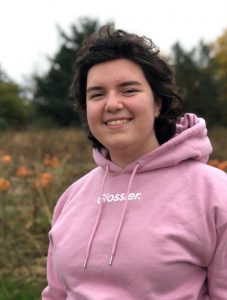**This post is a part of the series on the 2019 AGA Presidential Symposium – Sex and Asex: the genetics of complex life cycles**

About the Author: Adena Collens is an undergraduate student in her senior year at Smith College. She has enjoyed learning about protist diversity and genome evolution in Dr. Laura Katz’s lab at Smith. Adena is currently investigating the biodiversity of single-celled foraminifera communities on the shells of marine invertebrates for her honors thesis. She looks forward to continued research in evolutionary biology after graduation.
I started my research career at the very beginning — at the origin of eukaryotes.
Over the last 3 years, I have had the amazing opportunity to work in Dr. Laura Katz’s evolutionary biology lab as an undergraduate student at Smith College. Our work explores genome diversity within the world of microbial eukaryotes. Eukaryotes include animals, plants, fungi, and more than 100 groups of single-celled organisms including amoeba, ciliates, diatoms, foraminifera, and many more. Put another way, every multicellular organism you have ever seen in your life only represents a tiny fraction of total eukaryotic diversity! My love of evolution has grown from this humbling perspective. The history of life is so much more complex than we are ever taught to believe.
When students start out in the Katz Lab, Laura challenges them with a simple but meaningful goal — learn how to do research in a lab. As a graduating senior, I look back at my experience and believe I tried my hardest to achieve this deceptively simple goal.
I’ve now worked on almost every “team” in our lab–we are separated into groups based on the eukaryotic microbes we study–amoeba team, ciliate team, foraminiferan team, and symbiosis team, to name a few. Each team addresses the questions of eukaryotic diversity and genome evolution differently. Through single-cell and community sequencing, microscopy, and bioinformatics, I’ve learned about the survival strategies of our eukaryotic contemporaries.
While I’ve only begun to learn about the incredible diversity of these overlooked eukaryotes, all of our work converges on this central question: What was our first eukaryotic ancestor like? What did its genome do? How did it survive?
In my time working with Laura, I’ve learned not only how to collect data and perform analyses, but how to convey our ideas to the outside world. In June of 2019 at the AGA Presidential Symposium, Dr. Katz gave a presentation on Germline/soma distinction across the (eukaryotic) tree of life. Her talk described how eukaryotic genome diversity reveals likely traits of our most ancient eukaryotic ancestor. I recently had the chance to expand upon this lecture with her. We translated it into a review of her research’s central question in our article published in the 2021 Journal of Heredity Symposium Issue.
In our Katz Lab teams, mentoring goes bottom-up. This means my research is often first supported and critiqued by my teammates — post-doctorates, PhD candidates, master’s students, lab technicians, and fellow undergrads. We then present our work to Laura at weekly team meetings. However, when writing this review, this was not the case. Working directly with Laura about the central questions of her research was as daunting as it was exciting. During our revisions, for instance, I become overwhelmed by the mess of opinions surrounding the issue of the exact timing of events leading up to the first eukaryotic cell. Despite this, Laura always helped me zoom back out to the bigger picture. This piece, in her words, is short and fun. Her insistence on that idea helped me ease into the work and feel confident in the way our short article could present the implications for her research on the origin of eukaryotic life.
Our in-person work in the lab was disrupted when we were sent home from Smith in March 2020 due to COVID19. We had to complete our research remotely. Writing this article became a respite for me in this overwhelming new reality in the wake of lost in-person research opportunities. This project was truly one of the silver linings of my remote undergraduate experience last year.
In the article, we tackle some large questions about the origin of eukaryotes. Grappling with each one was a challenge, but building the pieces of our hypothesis in response was a complex and rewarding task. I learned about the ways Laura’s research touched on and diverged from what we know about the chaos that took place at eukaryogenesis.
I hope you read our article, but if you’re simply interested in the highlights, I’ll break it down here. First, let’s start with the things we know about eukaryotes today. Members of the Katz Lab have argued that epigenetic regulation and the separation of DNA for reproduction is found across the eukaryotic tree of life. This means these traits were likely present in our last eukaryotic common ancestor. We also know that eukaryotic genomes interact with and epigenetically regulate many types of mobile genetic material (transposons and viruses) in our cells and from the environment. Our article combines these observations. We argue that we can infer there was epigenetic interaction and regulation of mobile genetic elements in our last eukaryotic common ancestor because we now observe these features in the genomes of modern eukaryotes.
I am humbled and grateful for the mentorship Laura has provided me throughout this process and during my time at Smith. As she always says, science is inherently collaborative. As a woman in STEM at a historically-women’s institution, I know that beginning my research career in the Katz Lab has positioned me well to pursue my passion for evolutionary biology.
References
Collens AB, Katz LA (2021) Opinion: Genetic Conflict With Mobile Elements Drives Eukaryotic Genome Evolution, and Perhaps Also Eukaryogenesis. Journal of Heredity 112: 140-144.



